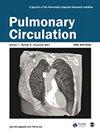下载PDF
{"title":"评估肺动脉高压患者的生活质量:一个独立的预后指标","authors":"Glenn Edward Malcolm Reeves, Julie Shepherd, Nicholas John Collins, Scott Twaddell, Rajinder Harjit Singh","doi":"10.1002/pul2.12380","DOIUrl":null,"url":null,"abstract":"<p><p>Pulmonary arterial hypertension (PAH, or PH Group 1), a disease of aberrant pulmonary vascular remodeling, causing progressive right heart failure (RHF) due to elevation of pulmonary vascular resistance (PVR). Patient mortality risk stratification guides choice and intensity of pharmacological intervention and is assessed by haemodynamics (especially PVR) as well as noninvasive tools including WHO functional class (FC), 6-min walk distance (6MWD), and NT-proBNP levels. Quality of life (QOL) assessment is acknowledged as a central aspect of patient-centered care, but our study sought to extend QOL's role as an additional noninvasive risk marker that could further refine risk stratification and hence therapeutic choices within a \"treatment to target\" paradigm (aiming to achieve low-risk status). This study found that QOL assessment using the PAH-SYMPACT© physical activity tool provided enhanced, independent mortality risk information, with one unit rise in this score associated with a 41% increase in likelihood risk (odds ratio 1.41, 95% confidence interval: 1.01-1.98 (<i>p</i> < 0.05)) of falling within intermediate versus low-group category. We therefore found further support for additional prognostic value being conferred by measurement of QOL as part of routine PAH evaluation, reinforcing its critical role.</p>","PeriodicalId":20927,"journal":{"name":"Pulmonary Circulation","volume":"14 2","pages":"e12380"},"PeriodicalIF":2.2000,"publicationDate":"2024-06-02","publicationTypes":"Journal Article","fieldsOfStudy":null,"isOpenAccess":false,"openAccessPdf":"https://www.ncbi.nlm.nih.gov/pmc/articles/PMC11144421/pdf/","citationCount":"0","resultStr":"{\"title\":\"Assessing quality of life in pulmonary arterial hypertension: An independent prognostic marker.\",\"authors\":\"Glenn Edward Malcolm Reeves, Julie Shepherd, Nicholas John Collins, Scott Twaddell, Rajinder Harjit Singh\",\"doi\":\"10.1002/pul2.12380\",\"DOIUrl\":null,\"url\":null,\"abstract\":\"<p><p>Pulmonary arterial hypertension (PAH, or PH Group 1), a disease of aberrant pulmonary vascular remodeling, causing progressive right heart failure (RHF) due to elevation of pulmonary vascular resistance (PVR). Patient mortality risk stratification guides choice and intensity of pharmacological intervention and is assessed by haemodynamics (especially PVR) as well as noninvasive tools including WHO functional class (FC), 6-min walk distance (6MWD), and NT-proBNP levels. Quality of life (QOL) assessment is acknowledged as a central aspect of patient-centered care, but our study sought to extend QOL's role as an additional noninvasive risk marker that could further refine risk stratification and hence therapeutic choices within a \\\"treatment to target\\\" paradigm (aiming to achieve low-risk status). This study found that QOL assessment using the PAH-SYMPACT© physical activity tool provided enhanced, independent mortality risk information, with one unit rise in this score associated with a 41% increase in likelihood risk (odds ratio 1.41, 95% confidence interval: 1.01-1.98 (<i>p</i> < 0.05)) of falling within intermediate versus low-group category. We therefore found further support for additional prognostic value being conferred by measurement of QOL as part of routine PAH evaluation, reinforcing its critical role.</p>\",\"PeriodicalId\":20927,\"journal\":{\"name\":\"Pulmonary Circulation\",\"volume\":\"14 2\",\"pages\":\"e12380\"},\"PeriodicalIF\":2.2000,\"publicationDate\":\"2024-06-02\",\"publicationTypes\":\"Journal Article\",\"fieldsOfStudy\":null,\"isOpenAccess\":false,\"openAccessPdf\":\"https://www.ncbi.nlm.nih.gov/pmc/articles/PMC11144421/pdf/\",\"citationCount\":\"0\",\"resultStr\":null,\"platform\":\"Semanticscholar\",\"paperid\":null,\"PeriodicalName\":\"Pulmonary Circulation\",\"FirstCategoryId\":\"3\",\"ListUrlMain\":\"https://doi.org/10.1002/pul2.12380\",\"RegionNum\":4,\"RegionCategory\":\"医学\",\"ArticlePicture\":[],\"TitleCN\":null,\"AbstractTextCN\":null,\"PMCID\":null,\"EPubDate\":\"2024/4/1 0:00:00\",\"PubModel\":\"eCollection\",\"JCR\":\"Q2\",\"JCRName\":\"CARDIAC & CARDIOVASCULAR SYSTEMS\",\"Score\":null,\"Total\":0}","platform":"Semanticscholar","paperid":null,"PeriodicalName":"Pulmonary Circulation","FirstCategoryId":"3","ListUrlMain":"https://doi.org/10.1002/pul2.12380","RegionNum":4,"RegionCategory":"医学","ArticlePicture":[],"TitleCN":null,"AbstractTextCN":null,"PMCID":null,"EPubDate":"2024/4/1 0:00:00","PubModel":"eCollection","JCR":"Q2","JCRName":"CARDIAC & CARDIOVASCULAR SYSTEMS","Score":null,"Total":0}
引用次数: 0
引用
批量引用


